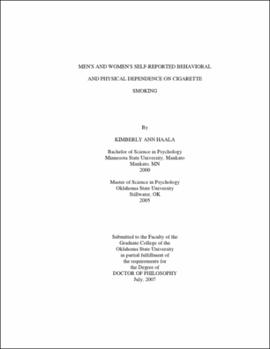| dc.contributor.advisor | Collins, Frank L., Jr. | |
| dc.contributor.author | Haala, Kimberly Ann | |
| dc.date.accessioned | 2013-11-26T08:27:39Z | |
| dc.date.available | 2013-11-26T08:27:39Z | |
| dc.date.issued | 2007-07 | |
| dc.identifier.uri | https://hdl.handle.net/11244/6946 | |
| dc.description.abstract | Scope and Method of Study: The purpose of this study was to investigate the relationship between gender and self-reported dependence on cigarette smoking. Specifically, the study investigated whether gender differences existed between self-report on measures of behavioral dependence, physiological dependence, and craving. Participants included 109 students from a college in Oklahoma. Of the 109 participants, 60 completed all five sessions of the study. All participants were current smokers. Participants were asked to complete the Fagerstrom Test for Nicotine Dependence, the Glover-Nilsson Smoking Behavior Questionnaire, the Smoking Consequences Questionnaire, and the Questionnaire on Smoking Urges. Participants were also asked to respond to diagnostic criteria of nicotine dependence from the Diagnostic and Statistical Manual of Mental Disorders, Fourth Edition, Text Revision (DSM-IV-TR). All research materials were accessed by participants via internet. Materials were presented on a webpage, and participants completed the questionnaires on their own time schedule. | |
| dc.description.abstract | Findings and Conclusions: Intra-class correlations indicated that reliability of self-report across the five time points was similar for men and women. MANOVA revealed no differences between men and women on self-report of physiological dependence, behavioral dependence, or craving. The MANOVA also indicated no significant differences in self-report across the five time points. Chi-Square indicated no significant differences in proportions of men and women classified as dependent by DSM-IV-TR criteria, and no significant difference in proportions of men and women who met DSM-IV-TR criteria for the specifier 'with physiological dependence'. Positive correlations were found to exist between measures of behavioral dependence, and between measures of behavioral dependence and craving. A similar pattern of results was found in participants who only completed one or two sessions of the study, and in analyses of the entire sample at Time 1. However, in participants who completed only part of the study as well as the entire sample, a larger proportion of nicotine dependent men met physiological dependence criteria. The results are inconclusive on whether differences exist in behavioral dependence, physiological dependence, and craving. It is possible that self-report measures of nicotine dependence are not adequately measuring these constructs. | |
| dc.format | application/pdf | |
| dc.language | en_US | |
| dc.rights | Copyright is held by the author who has granted the Oklahoma State University Library the non-exclusive right to share this material in its institutional repository. Contact Digital Library Services at lib-dls@okstate.edu or 405-744-9161 for the permission policy on the use, reproduction or distribution of this material. | |
| dc.title | Men's and women's self-reported behavioral and physical dependence on cigarette smoking | |
| dc.contributor.committeeMember | Leffingwell, Thad Ryan | |
| dc.contributor.committeeMember | Thomas, David G. | |
| dc.contributor.committeeMember | Jacobs, Sue C. | |
| osu.filename | Haala_okstate_0664D_2392 | |
| osu.accesstype | Open Access | |
| dc.type.genre | Dissertation | |
| dc.type.material | Text | |
| thesis.degree.discipline | Psychology | |
| thesis.degree.grantor | Oklahoma State University | |
